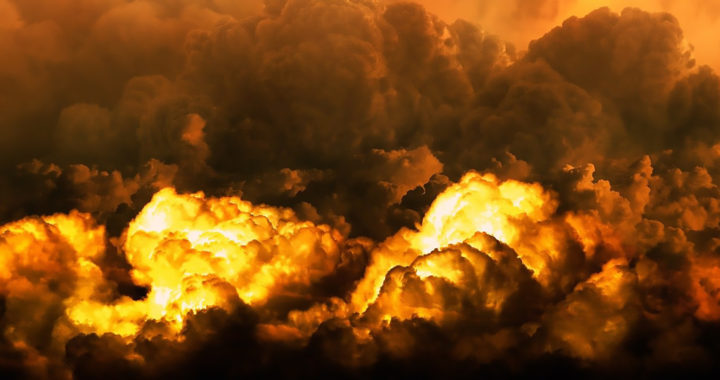A thermobaric weapon or vacuum bomb is a specific type of an explosive weapon that produces a high-temperature explosion by sucking in and using oxygen from the surrounding air. It is also referred to as aerosol bombs or fuel air explosives.
Germany has been attributed for being the first to develop thermobaric weapons during the Second World War. Austrian physicist Mario Zippermayr was the recognized inventor. The United States also developed fuel air explosives for use in the Vietnam War.
The Soviet Union responded to developments in the U.S. weapons arsenal during the Cold War by developing their own fuel air explosives. Reports suggest that the Soviets used these weapons during the Sino-Soviet conflict and against the Mujahideen in Afghanistan.
After the collapse of the Soviet Union in 1991, thermobaric weapons have become part of the military capabilities of the Russian Armed Forces. These weapons have also become of the arsenal of the United States Armed Forces.
Two of the most popular thermobaric bombs are the Aviation Thermobaric Bomb of Increased Power or the “Father of All Bombs” of Russia, and the GBU-43/B Massive Ordnance Air Blast or “Mother of All Bombs” of the United States.
Nevertheless, these explosive weapons have been regarded as one of the most devastating weapons a country can have in its arsenal. But how do thermobaric or vacuum bombs actually work? What makes them too lethal and devastating?
Understanding the Operational Mechanism Behind a Thermobaric Weapon
The fundamental mechanism of this explosive can be understood by examining the nomenclature used. Hence, as a backgrounder, the word “thermobaric” is derived from the Greek word “thermos,” which means “heat,” and “baros,” which means “pressure.”
However, for a more detailed explanation, note that this weapon is characterized by a two-stage munition. The first stage involves the distribution of aerosol composed of very fine material such as metal particles or powders or carbon-based fuel.
Fundamentally, after the weapon is dropped or fired, the first explosive charge opens a container that disperses an aerosol to form a cloud of fuel. This cloud spreads across the surroundings and around objects. It can also sip through structures.
Remember that the first stage creates and distributes a fuel cloud in the surrounding. The second stage then ignites this cloud, thereby creating a high-temperature fireball, a huge shockwave, and a vacuum that sucks in all the oxygen from the surrounding.
Weapons based on the aforesaid mechanism can take different forms and be launched using different delivery systems. They can be used in rocket launchers and guided missile systems or dropped as bombs using aircraft bombers.
Note that the Russian-designed Father of All Bombs is generally a bomber-deployed thermobaric weapon. The Russian Armed Forces also own other similar weapons using different delivery systems as part of their non-nuclear weapons arsenal.
Effects of the Explosion and Specific Impacts on Structures and Lives
The shockwave or blast wave created from the detonation of a thermobaric weapon or vacuum bomb can readily destroy unreinforced structures and equipment, kill individuals within the blast range, and several injure those that are nearby.
In addition, when compared with condensed bombs or other conventional non-thermobaric explosives, what makes this weapon excessively devastating and lethal is that the blast wave it can produce usually lasts significantly longer.
The effects on humans are horrifying. The weapon can vaporize a human body. Individuals at the outskirt or near the blast range can suffer from internal and invisible injuries such as crushed inner ear organs, ruptured lungs, damaged internal organs, or blindness.
What causes damage to a living species is the pressure wave, as well as the vacuum the explosion causes. Even if the weapon does not detonate completely, the high-temperature fuel cloud can still severely burn individuals or be inhaled.
Specific Strategical and Tactical Uses of Thermobaric Weapon
Armed forces with vacuum bombs at their disposal can resort to using these weapons to clear large areas and for anti-defense and anti-personnel purposes. The United States used these weapons as part of their “shock and awe” strategy in Iraq.
Because of the wide blast radius of these weapons, coupled with their significantly longer duration, they can also be used to overwhelm enemies and their defensive positions, destroy military bases or complexes, and dismantle a military formation.
They are also more effective when used in enclosed spaces such as bunkers, tunnel complexes, caves, and buildings. Russia used these weapons against the Mujahideen hiding in caves and enclosed natural spaces in Afghanistan mountains.
However, because the explosion from a thermobaric weapon has a large area of effect, they are not ideal for precision strikes. Furthermore, using them in areas with a significant number of civilian population has been criticized.
Note that the Geneva Convention prohibits the use of weapons in indiscriminate attacks or those strikes that cannot differentiate between combatants and civilians. The large area of effect of thermobaric weapons readily renders them an indiscriminate type of weapon.
FURTHER READINGS AND REFERENCES
- Hongwei, H. U., Pu, S., Guoqiang, D. and Chuan, X. 2022. “Characteristics of Thermobaric Explosives and Their Advances.” Advances in Mechanics. 52(1): 1-26. DOI: 6052/1000-0992-21-021
- Human Rights Watch. 2000. “Chechnya Conflict: Use of Vacuum Bombs by Russian Forces.” Human Rights Watch. Available online
- Türker, L. 2016. “Thermobaric and Enhanced Blast Explosives.” Defense Technology. 12(6): 423-445. DOI: 1016/j.dt.2016.09.002

